 By Bob Currie, Recreational Boating Safety Specialist,
By Bob Currie, Recreational Boating Safety Specialist,
U. S. Coast Guard Auxiliary Station Galveston Flotilla
There are valid reasons for not following ships and boats closely. This column will address how to use your judgment to maintain a proper distance from other vessels in a following situation.
Rules of the Road: Overtaking (Rule 13)
Rule 13 of the Navigation Rules says that “any vessel overtaking any other vessel shall keep out of the way of the vessel being overtaken.” 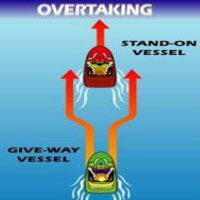 The whole idea of the Rules of the Road (also known as the Navigation Rules) is to avoid a collision. This rule places most of the responsibility for a collision on the following boat. There is more to a collision than hitting the hull of another vessel. A collision includes hitting anything being towed by another boat or hitting any rigging the vessel has in the water. A key part of the Overtaking Rule is that the overtaking vessel must signal an intent to pass, indicating on which side the overtaking vessel intends to pass the stand on vessel by using the proper horn signal.
The whole idea of the Rules of the Road (also known as the Navigation Rules) is to avoid a collision. This rule places most of the responsibility for a collision on the following boat. There is more to a collision than hitting the hull of another vessel. A collision includes hitting anything being towed by another boat or hitting any rigging the vessel has in the water. A key part of the Overtaking Rule is that the overtaking vessel must signal an intent to pass, indicating on which side the overtaking vessel intends to pass the stand on vessel by using the proper horn signal.
The Station Galveston Flotilla of the US Coast Guard Auxiliary operates out of the USCG Station Galveston base on Galveston Island. They aid the Coast Guard by providing maritime observation patrols in Galveston Bay; by providing recreational boating vessel safety checks; and by working alongside Coast Guard members in maritime accident investigation, small boat training, providing a safety zone, Aids to Navigation verification, cooking in the galley, on the Coast Guard Drone Team and watch standing.
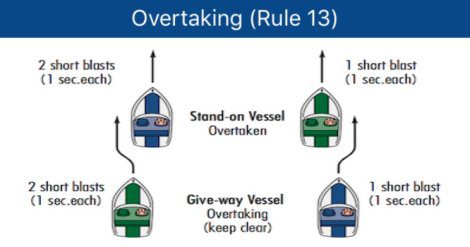
So far we have talked about a situation in which the following vessel is closing the distance between it and the vessel ahead. The question then becomes how close should you follow another vessel? The answer is it depends. The following factors should be taken into consideration when deciding how far back you should keep from a vessel you are following:
- Whether or not the vessel ahead is towing something (or someone)
- Whether or not you are towing something (or someone)
- How fast you are moving through the water
- How quickly can you stop from the speed in which you are moving
- Whether you have room to maneuver to port or starboard if necessary
- Whether the vessel ahead knows you are following
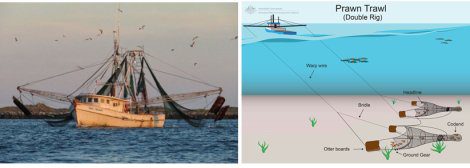
Vessels Towing Something
Although the shrimp boat above has its nets out of the water, the pictures gives you a general idea of how much room you should give a shrimp boat when overtaking it. But what about when you are trailing one? If you have ever been close to a shrimp boat that is fishing, you will notice a heavy line leading down into the water for each side of a double rig. The illustration above shows that the line as well as the nets can be quite a distance from the working shrimp boat. Besides the nets that can get entangled in your prop, each rig has heavy wooden boards that can destroy your lower unit should you hit them. In this case, Keep Back 500 Feet might be your best bet.
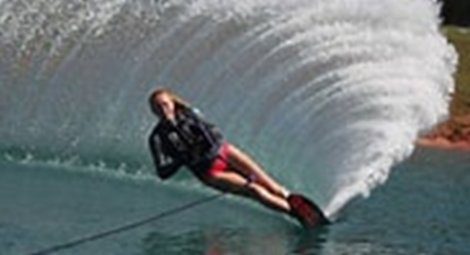
Vessels Towing Someone
Although the ship channel and the Intracoastal Waterway are primarily for commercial transportation, you will occasionally find recreational boats towing people on water skis, wave boards, and we even have a company that provides parasail rides. Those are vessels that you do not want to follow closely at all. In 2020, the last year for which recreational boating statistics have been compiled, there were 496 accidents involving towed water sports (up 32% from 2019), including 23 deaths (up 53% from 2019) and 439 injuries (up 20% from 2019). Some of the injuries and deaths involved the towed persons being run over by other boats. Pay close attention when you are in an area where towed watersports are taking place.
Speed Through the Water
Without the use of sight, humans cannot sense constant velocity. If you are on a plane flying at 600 mph, you have no sense of motion unless you look out the window and have some reference point. It is only when the plane changes speed or direction that your senses detect speed. If you close your eyes when traveling in a boat (or any other vehicle), you cannot tell how fast you are moving. It is only through visual observance can we sense how fast we are moving. If you are in a boat headed toward a stationary object, with experience you can make an estimate of closing speed, or you can simply look at your speedometer. But if you are moving toward a moving object, your ability to judge closing speed is strictly based on your experience. For that reason, you should not attempt to closely follow another vessel. A simple rule of thumb is to take your speed in mph and square it and use that as a minimum safe following distance in feet. Be sure to allow for vessels that are or may be towing something. Here is a simple table to illustrate my recommendation.

The recommended following distances might seem long until you factor in our poor ability to detect that the vessel we are following has slowed. You do not want to run over the boat ahead, and you do not want to toss your passengers about or even overboard trying to avoid a boat that you are following has slowed. That is how passengers end up in the water. Let’s look at an example of the math:
A boat that is moving 20 mph is moving 29.3 feet/second. If you are in a boat following that boat at a distance of 400 feet, then if the lead boat slows to 10 mph, if you don’t reduce speed you would ram that boat in about 27 seconds. That is a fair margin of time to recognize that the boat ahead has slowed and to allow you to adjust your speed to avoid a collision.
Taking the same scenario as above but if you are following at a distance of 200 feet, you would have less than 14 seconds to realize the boat ahead has slowed and to be able to react to avoid a collision. If you were following at 100 feet you would have 7 seconds to recognize the boat ahead has slowed and take evasive action to avoid a collision.
How Quickly Can You Stop
This factor is based on your ability to recognize the situation as much as it is on the ability of your boat to react to throttle and rudder changes. Quick stops in the water should be avoided as your wake will tend to overtake your stern and flood the boat. Another option is to steer to port or starboard, but in order to safely do so you have to know that you will not be putting a boat that is overtaking you in danger of colliding with your boat. Hopefully you have a stern watch who is keeping you apprised of any following or overtaking vessels. By quickly shutting off on your throttle you lose some or even all of your ability to steer to port or starboard. Boats that are jet driven can only maneuver under power. Quick maneuvers always put you at risk for throwing passengers overboard. Your best bet is to keep a safe following distance and keep a close watch for the lead vessel changing speed.
Room to Maneuver
Although we have the big blue sea all around us, we often have to navigate narrow channels such as entries to marinas and dredged channels with narrow passages. This often means you are not only following another boat through a channel but you are very likely to be followed by another boat. Having navigated the many narrow channels in the Clear Lake area, I can tell you this is not a time to kick back and relax. With heavy traffic moving in both directions through one of those narrow channels, you really want to emphasize that safe following distance and warn off any boat that is following you too closely, as your ability to maneuver to port or starboard to avoid a collision is minimal.
Vessel Ahead Knows You Are Following
It’s not wise to sneak up on someone. Collisions from the rear never end well. You can mitigate the danger of the possibility of a collision by communicating to the boat ahead that you are following them. If they wave you off, don’t take it personally. Back off using my recommended table for following distance and you should satisfy anyone that is worried about being closely followed.
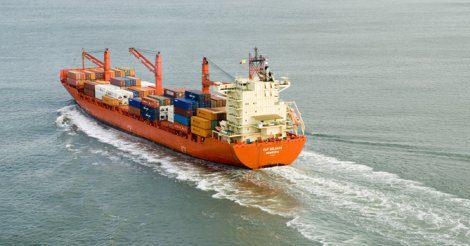
The Good Ship Lollipop
Following ships is a dangerous proposition. In the past we have had deaths due to recreational boats being capsized by large ship wakes. The Captain of the Port of Houston has specifically tasked us to get the information out about the dangers of large ship wakes and the waves they generate. Some of the largest ships in the world daily ply the Houston Ship Channel. Depending upon the speed in which they are moving, the average wave generated by a passing ship can be from five to ten feet high, and the larger ships create extremely powerful wakes from their 100,000 hp engines.
Passenger Ship Security Zones
Federal regulations specify how close you may come to passenger ships, and the regulations vary from port to port, but not by much. In the Houston-Galveston area, passenger ships including ferries have a 100-yard radius security zone. That means you may not come within 100 yards of a passenger ship whether moving or moored. Sometimes we (Coast Guard) escort large passenger ships to and from the port, and we may be closer than 100 yards. When we escort large ships, do not think that because we are close to the ships that you also can be close. Although the security zones are established for the safety of the ship, they also serve as a safety zone for smaller vessels.
Summary
Following another vessel can be quite a risky business, especially if the vessel is towing something such as shrimp nets or other tows that can’t easily be seen in the water, such as a dredge line. Post a good stern watch if you can so you aren’t surprised by another vessel following you, and keep a safe distance using the recommended speed table. Understand that circumstances can change at any time and the amount of time you have to react is based on your following distance.
For more information on boating safety, please visit the Official Website of the U.S. Coast Guard’s Boating Safety Division at www.uscgboating.org. Questions about the US Coast Guard Auxiliary or our free Vessel Safety Check program may be directed to me at [email protected]. SAFE BOATING!
[Mar-22-2022]

 Posted in
Posted in 
























